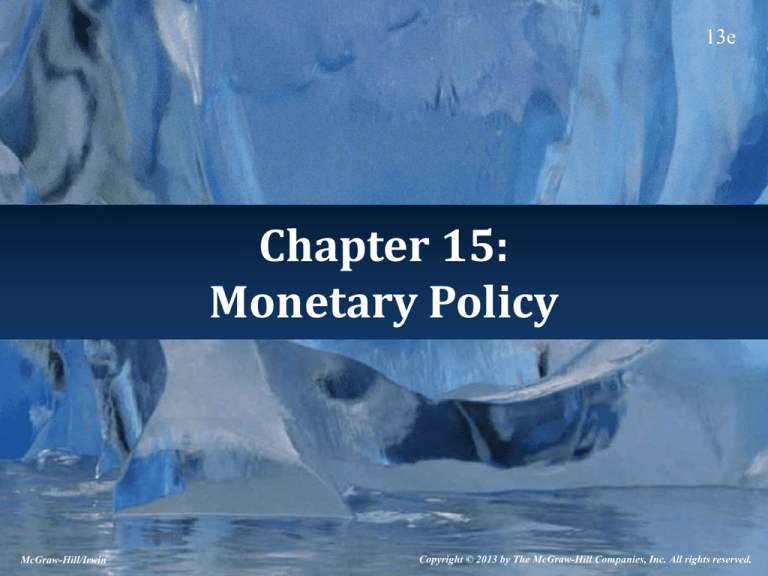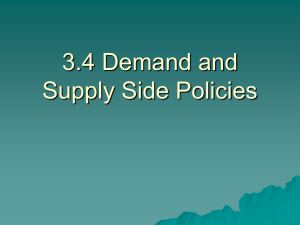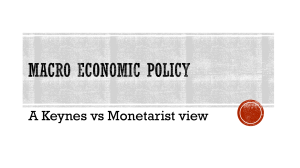
13e
Chapter 15:
Monetary Policy
McGraw-Hill/Irwin
Copyright © 2013 by The McGraw-Hill Companies, Inc. All rights reserved.
Monetary Policy
• Control over the money supply is a critical
policy tool for altering macroeconomic
outcomes.
– The quantity of money in circulation influences
its value in the marketplace.
– Interest rates and access to credit are basic
determinants of spending behavior.
• Therefore, the effectiveness of monetary
policy is of significance.
15-2
Learning Objectives
• 15-01. Explain how interest rates are set in the
money market.
• 15-02. Describe how monetary policy affects
macro outcomes.
• 15-03. Summarize the constraints on monetary
policy impact.
• 15-04. Identify the differences between
Keynesian and monetarist monetary theories.
15-3
The Money Market
• Money is like any other commodity. It is traded
in the marketplace.
– There is a money supply (controlled by the Fed)
and a money demand by the people.
– They determine the “price” of money: the interest
rate.
• At high interest rates, money is expensive to
acquire.
• At low interest rates, money is cheap to
acquire.
15-4
The Money Market
• If people hold cash as M1, they suffer an
opportunity cost: the forgone interest they
could have earned.
• Money demand: the quantities of money
people are willing and able to hold at
alternative interest rates, ceteris paribus.
– At low interest rates, the opportunity cost of
holding money is low, so people will hold more of it,
and vice versa.
15-5
The Demand for Money
• Why would people want to hold money – that
is, have a demand for money?
– Transactions demand: people need to hold money
for the purpose of making everyday market
purchases.
– Precautionary demand: people also hold money for
unexpected market transactions or for
emergencies.
– Speculative demand: some people also hold money
to be able to take advantage of an investment
opportunity in the near future.
15-6
Money Market Equilibrium
• Money demand: the
quantity of money
people are willing and
able to hold (demand)
increases as interest
rates fall, and vice versa.
• Money supply: since the
Fed controls the money
supply, it is represented
by a vertical line.
15-7
Money Market Equilibrium
• The intersection of
money demand and
money supply (E1)
establishes the
equilibrium rate of
interest.
15-8
Money Market Equilibrium
• If interest rates are
higher than equilibrium,
there is a money
surplus.
– People must hold more
money as M1 than they
wish.
– They will move money
out of M1 into M2 or
other assets (such as
bonds).
– The interest rate will then
fall to E1.
15-9
Money Market Equilibrium
• If interest rates are
lower than equilibrium,
there is a money
shortage.
– People must hold less
money as M1 than they
wish.
– They will move money
into M1 from M2 or other
assets (such as bonds).
– The interest rate will then
rise to E1.
15-10
Changing Interest Rates
• The Fed controls the money supply.
• By using the Fed policy tools, it can alter the
equilibrium rate of interest.
– By increasing the money supply (causing a
surplus), the Fed tends to lower the equilibrium
rate of interest.
– By decreasing the money supply (causing a
shortage), the Fed tends to raise the equilibrium
rate of interest.
15-11
Interest Rates and Spending
• Lowering interest rates is a tactic of monetary
stimulus, the purpose of which is to increase
aggregate demand (AD).
– Lower interest rates reduce the cost of investment
spending (most of which is done with borrowed
funds) and the cost of holding inventory.
Investment spending will increase.
– An investment spending increase is an injection
into the circular flow, and will kick off the multiplier
effect. AD will shift right because of this.
15-12
Interest Rates and Spending
• Raising interest rates is a tactic of monetary
restraint, the purpose of which is to decrease
aggregate demand (AD).
– Higher interest rates increase the cost of
investment spending (most of which is done with
borrowed funds) and the cost of holding inventory.
Investment spending will decrease.
– An investment spending decrease will kick off a
negative multiplier effect. AD will shift left because
of this.
15-13
Policy Constraints
• Short- vs. long-term rates.
– The Fed has greater influence on short-term
rates (that is, the Fed funds rate) than long-term
rates (mortgages and installment loans).
– The Fed’s monetary stimulus will be most
effective is long-term interest rate changes
mirror short-term rate changes.
– If not, the AD increase will be less than hoped
for.
15-14
Policy Constraints
• Reluctant lenders.
– The banking system must be willing to increase
lending activity.
– Banks may pile up excess reserves instead of
making loans.
– They might have concerns about their financial
well-being and about making loans to those who
might not pay back the money.
– They might be uncertain about how new bank
regulations may affect profitability.
15-15
Policy Constraints
• Liquidity trap.
– When interest rates are low, the opportunity cost of
holding money is also low.
– Lowering interest rates further might not elicit the
response desired by the Fed because people and
firms simply hold the money instead of investing.
– This is the liquidity trap:
• People are willing to hold unlimited amounts of money at
some low interest rate.
• The money demand curve becomes horizontal.
15-16
Policy Constraints
• Low expectations:
– Investment decisions are influenced by
expectations.
• In a recession, firms have little incentive to expand
production capability.
• There would be little expectation of future profit, or
“payoff,” from new investment.
– Consumers may be reluctant to take on added debt
when future income prospects are uncertain.
• Thus AD does not increase when interest rates
are reduced.
15-17
Policy Constraints
• Time lags:
– It takes time to develop and implement new
investments in response to lower interest rates.
– Consumers also may take time to decide to
increase their borrowing.
– It may take 6 to 12 months before market
behavior responds to monetary policy.
15-18
The Monetarist Perspective
• The Keynesian view of monetary policy says
that changes in the money supply affect macro
outcomes primarily through changes in
interest rates.
• The monetarist view is different. They believe
that only the price level is affected by Fed
policy … and then only by changes in the
money supply.
– They say monetary policy is not effective for
fighting recession, but is a powerful tool for
managing inflation.
15-19
The Equation of Exchange
• The equation of exchange is
MV = PQ
where M is the money supply, V is its velocity in circulation,
P is the average price, and Q is the quantity of goods sold.
• In this equation, total spending is price (P)
times quantity (Q). This spending is financed
by the money supply (M) times the velocity of
its circulation (V).
– Velocity (V): the number of times per year, on
average, that a dollar is used to purchase final
goods and services.
15-20
The Equation of Exchange
MV = PQ
• PQ is the same as nominal GDP.
• The quantity of money in circulation and the
velocity with which it exchanges hands will
always be equal to the value of nominal GDP.
• Monetarist view: If M increases, P or Q must
rise, or V must fall.
15-21
The Equation of Exchange
MV = PQ
• Assume V is stable – that is, does not change.
• V is a function of how people handle their
money and the institutions they use to do so.
Neither should change much in the short run.
• Thus total spending (PQ) must rise if money
supply (M) grows and velocity (V) is stable,
regardless of interest rates.
15-22
Money Supply Focus
• If spending increases when the money
supply grows, then the Fed should focus on
the money supply, not interest rates.
– Fed policy should not be to manipulate interest
rates.
– Fed policy should focus on the size and growth
of the money supply.
15-23
“Natural” Unemployment
MV = PQ
• Monetarists insert another perspective:
– Q is stable also. It is a function of productive capacity, labor
efficiency, and other “structural” forces.
– This leads to a “natural” rate of unemployment that is fairly
immune to short-run policy intervention.
• Natural rate of unemployment: the long-term rate of
unemployment determined by structural forces.
• Thus if both V and Q are stable, any increase in M in the
long run only increases P.
15-24
“Natural” Unemployment
MV = PQ
• If both V and Q are stable, any increase in M
in the long-run only increases P.
– If prices rise, costs of production will rise also,
so there is no profit incentive to increase Q.
– In the long run, the aggregate supply is vertical.
– Any increase in AD directly increases the price
level.
15-25
Monetarist: Fighting Inflation
• The policy goal is to reduce aggregate
demand.
– Keynesians: shrink the money supply and drive
up interest rates.
– Monetarists: interest rates are likely to be high
already. A decrease in the money supply will
lower nominal interest rates, not raise them.
15-26
Monetarist: Fighting Inflation
• Interest rates are likely to be high already. A
decrease in the money supply will lower
nominal interest rates, not raise them.
– Nominal interest rate: the interest rate we
actually see and pay.
– Real interest rate: the nominal rate minus the
anticipated inflation rate.
• As the money supply shrinks, the price level
falls and anticipated inflation decreases, so
nominal interest rates fall, not rise.
15-27
Monetarist: Fighting Inflation
• To close an inflationary GDP gap using monetary
policy, reduce the money supply.
– Keynesians: interest rates rise, reducing spending.
– Monetarists: once the people are convinced the Fed is reducing
money supply, anticipated inflation falls and nominal interest rates
will fall. Short-term rates will rise in response to the Fed action, but
long-term rates will react more slowly.
• Monetarists advise steady and predictable changes in
the money supply, to reduce uncertainty and thus
stabilize both long-term interest rates and GDP
growth.
15-28
Monetarist: Fighting Unemployment
• The policy goal is to increase aggregate demand.
– Keynesians: expand the money supply and drive down
interest rates.
– Monetarists: increased money supply leads to higher prices,
immediately raising people’s inflationary expectations. Longterm interest rates might actually rise, defeating the purpose
of monetary stimulus.
• Monetarists conclude that expansionary monetary
policy can’t lead us out of recession.
15-29









